Conservation and Survey Division
Scott Schrage, December 7, 2022
Rust-coated irrigation pipes hint at lack of nitrate in groundwater
Finding could guide sampling of groundwater for contaminant linked to health issues
Oh, we don’t have to worry about that area. They have red pivots.
On its face, the anecdote was clear enough. The “red” in question, Troy Gilmore knew, was rust. The pivots, meanwhile, were center pivots: elevated irrigation piping that rotates around a central point to distribute water in circular patterns most evident from 30,000 feet, where irrigated crops resemble massive green checkers crowding the pastoral checkerboard of the Corn Belt.
As for the worry? That would be nitrate, a fertilizer-derived compound that can leach into groundwater and, if consumed above certain concentrations via drinking water, pose threats to human health.
Still, the associate professor at the University of Nebraska–Lincoln found the offhand comment a bit surprising. Even with his extensive background in hydrology, Gilmore had never heard of any connection between rusty pivots and groundwater nitrate. But Marty Stange, the environmental supervisor with Hastings Utilities, was in the middle of explaining a reverse-osmosis water treatment facility that had recently gone into operation.
So Gilmore continued listening, filing the curiosity away in his head. Eventually, he would mention it to his then-doctoral advisee, Mikaela Cherry, who was working toward her doctorate in the School of Natural Resources.
“We’re like, ‘You know what? We should really look into that,’” recalled Cherry, who earned her doctorate from Nebraska U in December 2021. “‘Is that a thing? Where there are red pivots, there’s no nitrate?’”

Now, after dozens of hours peering at satellite imagery, compiling spreadsheets of data and driving the country roads of south-central Nebraska, Cherry and her colleagues have good reason to suspect that Stange was right. According to their research, red center pivots — specifically, those totally coated with reddish-brown iron pumped up from the aquifers below — seem to signify an absence of nitrate in whatever groundwater flows through its pipes.
Which isn’t to say that the lack of an iron patina means the neighboring groundwater is necessarily high in nitrate.
“A non-rusty pivot doesn’t really tell you anything,” said Cherry, now a physical scientist with the U.S. Geological Survey’s Nebraska Water Science Center. “But the presence of those rusty pivots is an indication that there isn’t (much) nitrate in the groundwater.”
‘They’re not random’
When Gilmore shared Stange’s anecdote with Cherry, her first instinct was to go out and test it via some good old-fashioned fieldwork. Unfortunately, the early stages of the COVID-19 pandemic had put a temporary halt to most of it. But Cherry had a thought: Maybe she could at least identify center pivots — and even discern how much of their surface area was covered in rust — by poring through Google Earth. With a little practice, she realized it was feasible, ultimately classifying 700 of the pivots into one of three categories: full-rust, part-rust or no-rust.
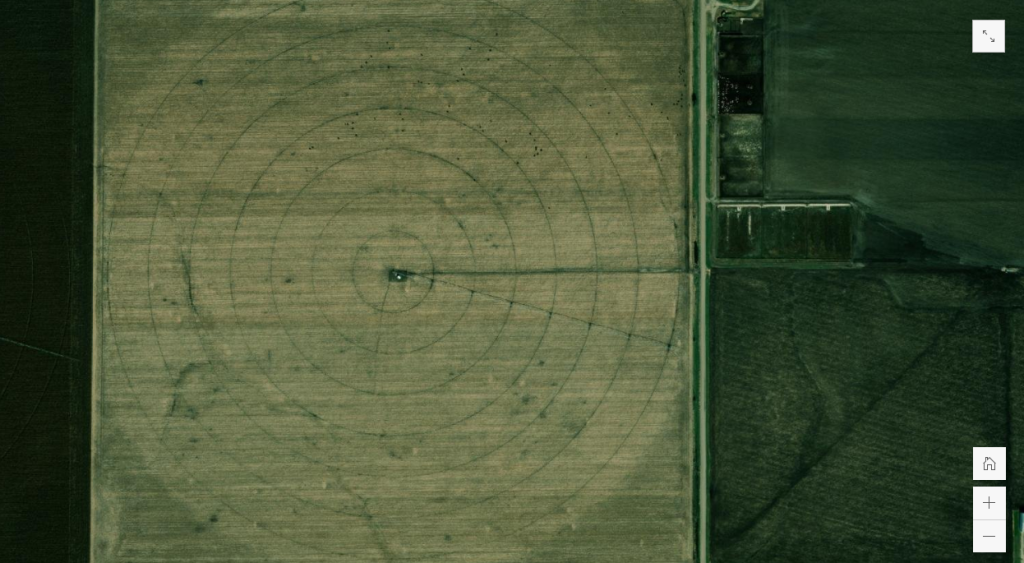
“I spent a long time staring at pivots on Google Earth,” she said, laughing. “And then, once we could start doing a bit more fieldwork again, going out and double-checking that the pivots I saw as rusty on Google Earth were actually rusty in real life.”
Cherry homed in on three irrigation-intensive Cornhusker State counties sitting atop the massive Ogallala Aquifer — Adams, Kearney and Phelps — where she had already conducted research since arriving at Nebraska in 2018. Before hitting the road, Cherry singled out 277 pivots to inspect.
She wouldn’t be alone. The pandemic had also disrupted tourism to the Grand Canyon, where Mikaela’s sister, Bethany, worked as a park ranger. With some newfound time on her hands, Bethany decided to ride shotgun for the three-day research road trip. Together, the sisters tracked down the pivots, photographing and successfully classifying about 250 of them.
“It was a lot of fun,” Mikaela said. “You kind of get into a rhythm.”
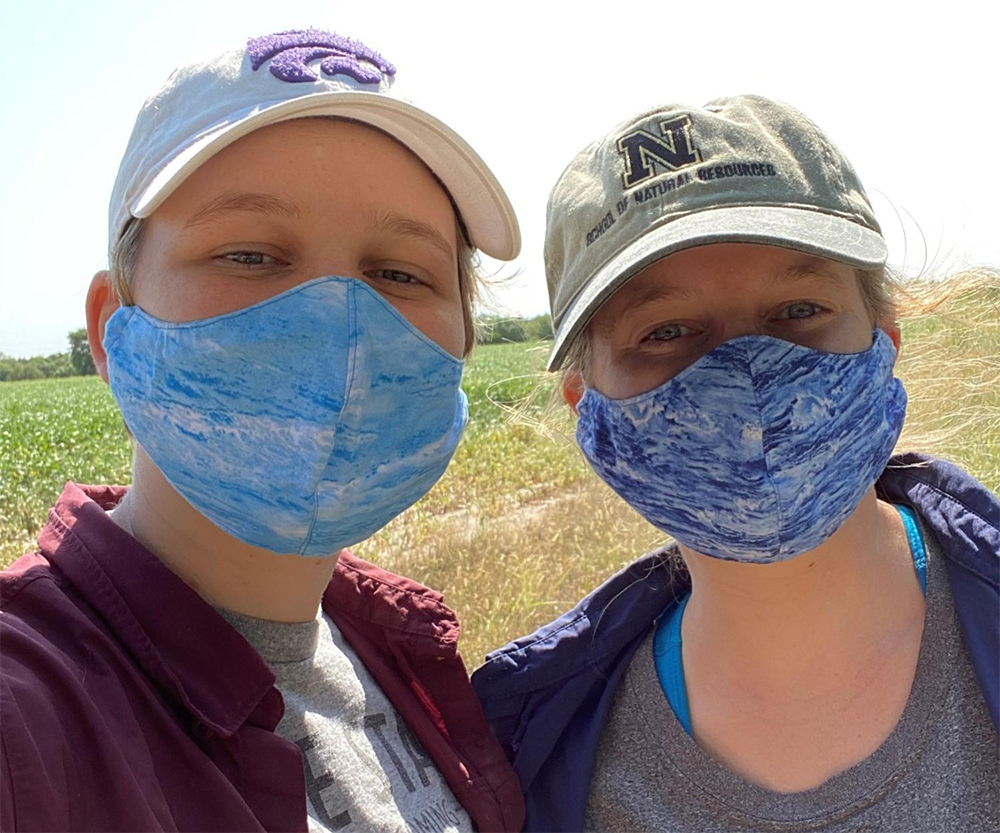
As it turned out, her Google Earth reconnaissance was worthwhile: In 83% of cases, the sisters’ ground-based classifications of the pivots matched up with Mikaela’s satellite-based classifications. She then set out to compare the rustiness of each pivot with the most recent nitrate reading from the groundwater that fed it, relying on a groundwater database co-developed by the Nebraska Department of Agriculture and University of Nebraska–Lincoln.
Cherry was especially interested in whether the respective nitrate concentrations were above or below 10 milligrams per liter, which the Environmental Protection Agency established in 1991 as the maximum concentration safe for human consumption. That standard arose from the emergence of blue-baby syndrome, in which the skin of an infant turns blue — often a consequence of drinking formula prepared from high-nitrate well water, which can reduce oxygen levels in the blood. Multiple studies have likewise linked nitrate with higher incidence of birth defects and several cancers.
After cross-referencing the locations of the pivots with their groundwater nitrate concentrations, Cherry discovered that none of the 76 groundwater wells feeding into the full-rust pivots contained nitrate above the 10 mg/L threshold. In fact, the average nitrate concentration of those sources was just 2.4 mg/L. Most, though not all, of the groundwater supplied to the part-rust pivots also sat below the nitrate threshold, with an average concentration of 4.5 mg/L but a maximum of nearly 23 mg/L.
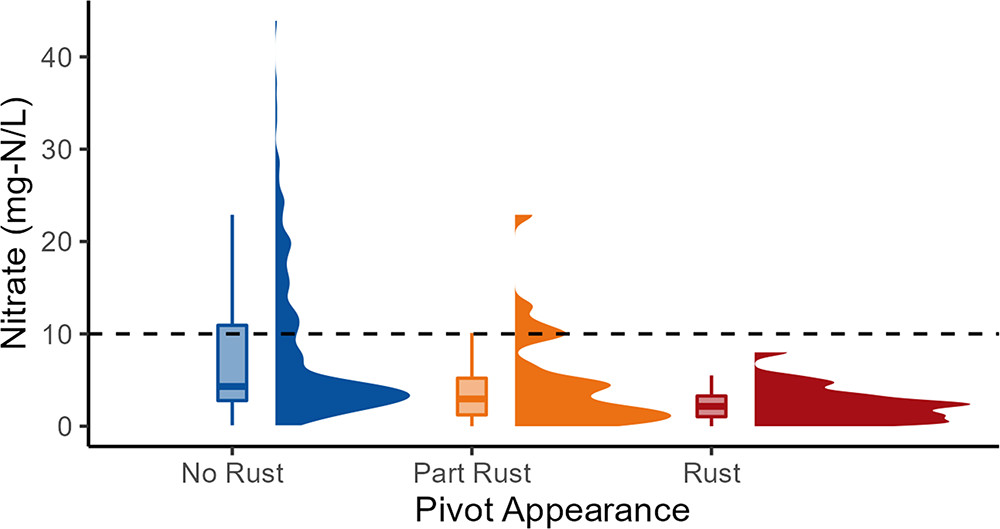
Though a majority of the no-rust pivots did draw from groundwater wells below the EPA threshold, averaging 7.8 mg/L, many others did not. One of the wells supplying a no-rust pivot measured out at nearly 44 mg/L, more than four times the EPA limit. And statistical analyses confirmed a clear difference — one very unlikely to be due to chance — between the nitrate concentrations associated with the full-rust versus no-rust pivots.
“So there seems to be a pretty strong correlation between the rust and the nitrate,” said Cherry, who did note that larger sample sizes could lend further support to the team’s conclusion.
During the three-day field expedition through south-central Nebraska, Cherry also began noticing a pattern that was borne out when she later mapped the pivots according to their ground-based classifications.
“The rusty pivots tend to occur in patches,” she said. “They’re not random. You see clumps of them together throughout the study area.”
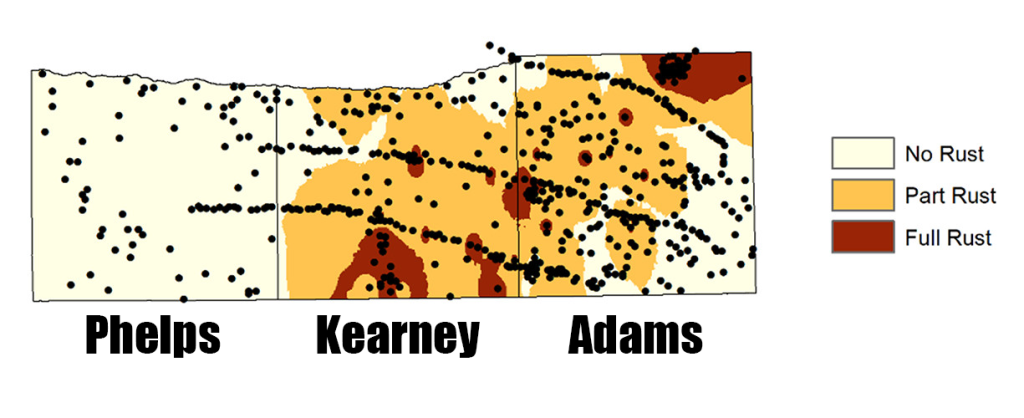
A map of Phelps, Kearney and Adam counties overlaid with center pivots (black dots) identified by the team. Based on the rust classifications of those observed pivots, the team then estimated areas of no-rust (white), part-rust (yellow) and full-rust (red) pivots across the three counties. Adapted from figure in ACS ES&T Water / American Chemical Society
Microbes, Snickers and the Farmer’s Almanac
Naturally, Cherry, Gilmore and fellow researchers Jeffrey Westrop, Yusong Li and Tiffany Messer were curious about what, exactly, was responsible for the nitrate-rust link. They’re still not sure, but they do have a hypothesis — one involving the countless microorganisms, especially bacteria, that live in soil and groundwater.
Aquifer-dwelling microbes often owe their survival to organic carbon, which lends them electrons that fuel their metabolism. Some of the chemical reactions essential to their survival, though, also depend on donating electrons to elements or compounds in their vicinity. Multiple elements and compounds are willing to accept microbial electrons, but the microbes will only donate those electrons in the most energy-efficient way possible.
“What they ‘eat’ is based off what’s there and what is energetically easiest,” Cherry said. “It’s like a human deciding to eat a Snickers versus some lettuce. The Snickers is going to give them the easiest energy.”
So the microbes prioritize the recipients of their electrons: dissolved oxygen first, followed by nitrate, manganese and then iron. By lending an electron to the iron found in groundwater, microbes convert it to a form that oxidizes, or rusts, if it gets pumped to the surface and exposed to oxygen — explaining why some center pivots become coated with the reddish-brown hue even when they’re not corroding.
But the fact that microbes resort to iron only after using up nitrate, Cherry said, suggests that most or all of the available nitrate in that same groundwater has already been consumed. And that could potentially explain why a red pivot seems to indicate the absence of nitrate in the aquifer beneath it.
“This is just our proposed mechanism,” Cherry said. “This is, logically, what we think could be happening.”
Of course, an aquifer has to contain iron for the pivots above it to turn red in the first place. Because not all aquifers do, Cherry said the proposed color-coded system is only applicable in areas that feature their fair share of the element. Typically, those are areas adjacent to streams or rivers — including the Platte, in the case of south-central Nebraska.
Aside from its abundance of aquifer-irrigated farmland, south-central Nebraska was a prime location for Cherry’s study in part because the area’s Natural Resources Districts, or NRDs, have long monitored the groundwater for nitrate and other contaminants. While Omaha, Lincoln and other metro areas have the infrastructure to continually monitor all of their potable water, NRDs in rural areas sample subsets of their groundwater locations on a rotating basis. In south-central Nebraska, the Tri-Basin and Little Blue NRDs devote roughly one month a year to sampling wells, Cherry said. And though the process may be well-established, it’s not cheap.
A new survey of rural Nebraskans, meanwhile, found that roughly 25% get their water from private wells. Of that subset, just 55% said they have their water tested specifically for nitrate. Cherry said she can envision a future in which rural residents and even NRDs consult center pivots as a sort of Farmer’s Almanac shorthand by which to screen areas for the potential absence of nitrate.
“If you’re in an area where you know this township pretty much has exclusively rusty pivots, perhaps you’re only going to sample one or two wells. Whereas this (other) township doesn’t have any rusty pivots. Maybe you sample more wells there, so you get a better idea of where the nitrate is,” she said. “So you could strategically sample based on where you think nitrate might be an issue.”
The method could prove especially relevant in countries, such as Brazil, that are broadly expanding their use of irrigation, Cherry said. Developing countries that currently lack the resources to sample their groundwater on a regular basis might also find some value in turning to their pivots for guidance.
“In an ideal world,” she said, “this could be an application that might be used to source out areas at higher or lower risk for nitrate contamination — before it even happens.”
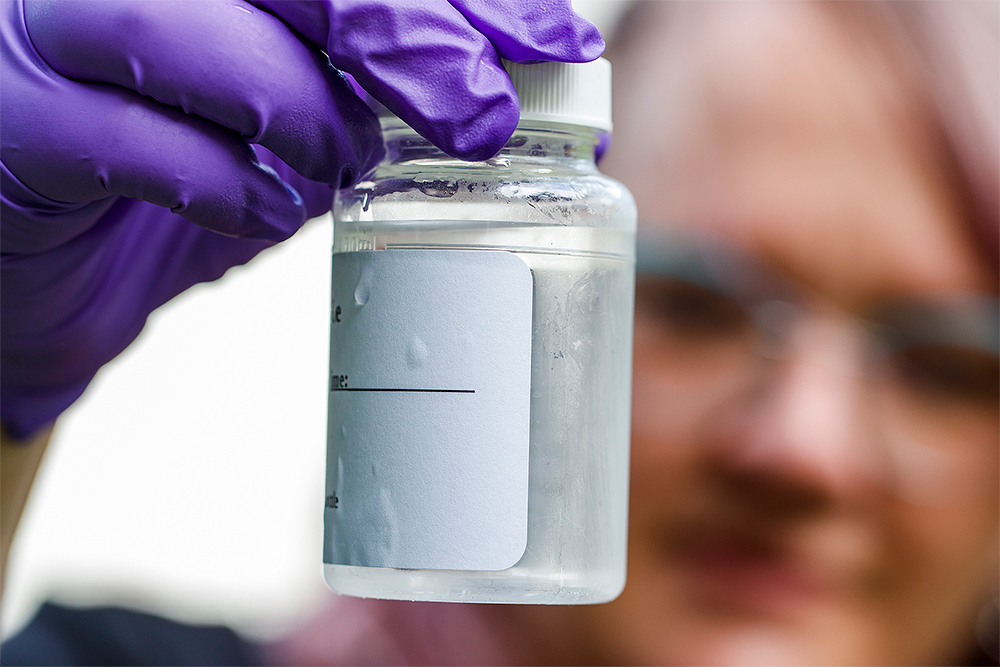
Nebraskans interested in testing their wells for nitrate can contact the University of Nebraska–Lincoln’s Shannon Bartelt-Hunt (sbartelt2@unl.edu, 402-554-3868) about taking part in a citizen-science program. Participants receive free testing materials, training and results.
More information about groundwater nitrate can be found at https://nebraskawaves.org.
Conservation and Survey Division Institute of Agriculture and Natural Resources School of Natural Resources





